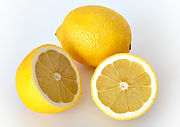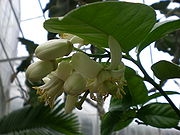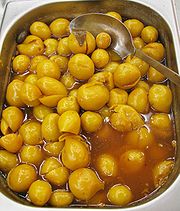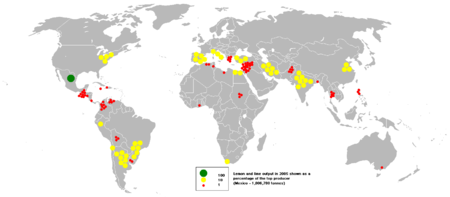
Lemon
Did you know...
SOS Children volunteers helped choose articles and made other curriculum material SOS Children works in 45 African countries; can you help a child in Africa?
| Lemon | |
|---|---|
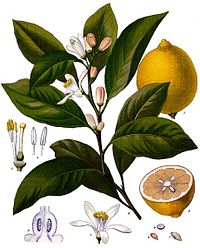 |
|
| Citrus x lemon | |
| Scientific classification | |
| Kingdom: | Plantae |
| Division: | Magnoliophyta |
| Class: | Magnoliopsida |
| Subclass: | Rosidae |
| Order: | Sapindales |
| Family: | Rutaceae |
| Genus: | Citrus |
| Species: | C. × limon |
| Binomial name | |
| Citrus × limon (L.) Burm.f. |
|
The lemon (Citrus × limon) is a hybrid in cultivated wild plants. It is the common name for the reproductive tissue surrounding the seed of the angiosperm lemon tree. The lemon is used for culinary and nonculinary purposes throughout the world. The fruit is used primarily for its juice, though the pulp and rind ( zest) are also used, primarily in cooking and baking. Lemon juice is about 5% (approximately 0.03 moles/Liter) citric acid, which gives lemons a tart taste, and a pH of 2 to 3. This makes lemon juice an inexpensive, readily available acid for use in educational science experiments.
History
The exact origin of the lemon has remained a mystery, though it is widely presumed that lemons are wildly grown in both India and China. In South and South East Asia, it was known for its antiseptic properties and it was used as antidote for various poisons. The lemon was later introduced to Iraq and Egypt around 700 A.D.
The popular drink lemonade may have originated in medieval Egypt. It was distributed widely throughout the Arab world and the Mediterranean region between 1000 A.D. to 1150 A.D. At this time, the lemon was first recorded in literatures to a tenth century Arabic treatise on farming and was used as an ornamental plant in early Islamic gardens.
Lemons entered Europe (near southern Italy) no later than the first century AD, during the time of Ancient Rome. However, they were not widely cultivated. The first real lemon cultivation in Europe began in Genoa in the middle of the fifteenth century. It was later introduced to the Americas in 1493 when Christopher Columbus brought lemon seeds to Hispaniola along his voyages. Spanish conquest throughout the New World helped spread lemon seeds. It was mainly used as ornament and medicine. In 1700s and late 1800s, lemons were increasingly planted in Florida and California when lemons began to be used in cooking and flavoring.
In 1747, James Lind's experiments on seamen suffering from scurvy involved adding Vitamin C to their diets through lemon juice.
The name lemon was originated from Arabic līmūn لیمون and Persian limun through Old Italian and Old French limone..
Culinary uses
Lemons are used to make lemonade, and as a garnish for drinks. Many mixed drinks, soft drinks, Iced tea, and water are often served with a wedge or slice of lemon in the glass or on the rim. The average lemon contains approximately 3 tablespoons of juice. Allowing lemons to come to room temperature before squeezing (or heating briefly in a microwave) makes the juice easier to extract. Lemons left unrefrigerated for long periods of time are susceptible to mold.
Fish are marinated in lemon juice to neutralize the odour. The acid neutralizes the amines in fish by converting them into nonvolatile ammonium salts.
Lemon juice, alone or in combination with other ingredients, is used to marinate meat before cooking: the acid provided by the juice partially hydrolyzes the tough collagen fibers in the meat ( tenderizing the meat), though the juice does not have any antibiotic effects.
Lemons, alone or with oranges, are used to make marmalade. The grated rind of the lemon, called lemon zest, is used to add flavor to baked goods, puddings, rice and other dishes. Pickled lemons are a Moroccan delicacy. A liqueur called limoncello is made from lemon rind.
When lemon juice is sprinkled on certain foods that tend to oxidize and turn brown after being sliced, such as apples, bananas and avocados, the acid acts as a short-term preservative by denaturing the enzymes that cause browning and degradation.
Non-culinary uses
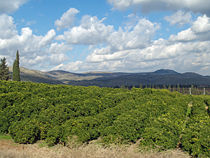
- Citric acid - Lemons were the primary commercial source of this substance prior to the development of fermentation-based processes.
- Lemon battery - A popular science experiment in schools involves attaching electrodes to a lemon and using it as a battery to power a light. The electricity generated in this way can also power a small motor. These experiments also work with other fruits and vegetables.
- Sanitary kitchen deodorizer - deodorize, remove grease, bleach stain, and disinfect; when mixed with baking soda, lemon can remove stains from plastic food storage containers.
- Lemon hair lightener - Lemon juice applied to the hair can work as a natural hair lightener.
- Insecticide - The d-limonene in lemon oil is used as a non-toxic insecticide treatment. See orange oil.
- Acne Treatment - Applying lemon juice to facial blemishes is a popular form of treating acne.
- When lemon juice is mixed with Sun In it is said to lighten the hair or to enhance highlights. melanin production. The effectiveness, however, is largely a subject of debate.
- Lemon skins eaten daily have been shown to greatly increase the muscle recovery and anti-catabolic cycles for increased muscle development. Research has shown that 8 oz. of lemon peels is the recommend maximum daily dosage.
- Lemon is used in facial masks for refreshing the skin.
- Wood treatment - lemon oil is often used on the unsealed rosewood fingerboards of guitars and other stringed instruments. It should not be used on maple fingerboards, as these are generally sealed and the oil would just stay on the surface.
- Lemon juice is often used to clean the inside of animal skins prior to taxidermy.
- Natural deodorants are generally made from lemon extracts. Raw lemon can be used as a short term deodorant.
- Aromatherapy - Researchers at Ohio State University reveals that lemon oil aroma may enhance your mood, and relax you.
Lemon alternatives
Several other plants have a similar taste to lemons. In recent times, the Australian bush food lemon myrtle has become a popular alternative to lemons. The crushed and dried leaves and edible essential oils have a strong, sweet lemon taste but contain no citric acid. Lemon myrtle is popular in foods that curdle with lemon juice, such as cheesecake and ice cream. Limes are often used instead of lemons.
Many other plants are noted to have a lemon-like taste or scent. Among them are Cymbopogon (lemon grass), lemon balm, lemon thyme, lemon verbena, scented geraniums, certain cultivars of basil, and certain cultivars of mint.
